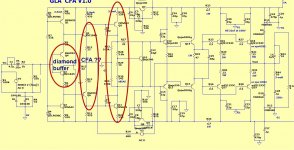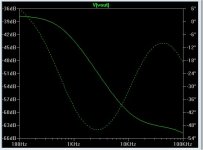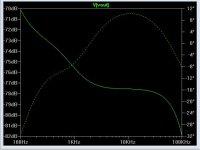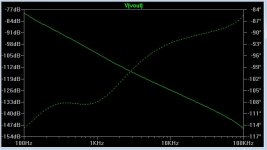Diamond input has the same out-of the feedback buffer, that's why I don't like them at all. Its signature is clearly audible, even more than bad input cables.
This is absolute nonsense.
The diamond input structure allows you to throw out all the coupling caps and go with direct coupling.
Since the distortion of the open input buffers is single digit ppm ( please see Dadods designs for example), I fail to see how the sonic signature is greater than that of the big electrolytics in competing designs. The DC stability is also very good, and the PSRR is also better with the diamond.
The diamond front end is not from Hiraga. It's been described in professional literature in the 1970''s with the first commercially available devices from Comlinear.
The diamond input structure allows you to throw out all the coupling caps and go with direct coupling.
Since the distortion of the open input buffers is single digit ppm ( please see Dadods designs for example), I fail to see how the sonic signature is greater than that of the big electrolytics in competing designs. The DC stability is also very good, and the PSRR is also better with the diamond.
The diamond front end is not from Hiraga. It's been described in professional literature in the 1970''s with the first commercially available devices from Comlinear.
Maybe not of Hiraga origin, but also used by Hiraga in his famous 20/30W
But I tend to agree with LC, no need for the input-buffer I have had no input offset on any of my CFA's without any input buffer.
I also agree- that diamond buffers are lifeless- at least when compared to a buffer like the one Calvin has designed. This I know from practical building.
/M
But I tend to agree with LC, no need for the input-buffer I have had no input offset on any of my CFA's without any input buffer.
I also agree- that diamond buffers are lifeless- at least when compared to a buffer like the one Calvin has designed. This I know from practical building.
/M
Diamond input has the same out-of the feedback buffer, that's why I don't like them at all. Its signature is clearly audible, even more than bad input cables.



I also agree- that diamond buffers are lifeless- at least when compared to a buffer like the one Calvin has designed.
"Lifeless", don't you love it? 😛 Do you have the foggiest idea what a "diamond buffer" brings to the table?
I know how it sounds compared to the calvin buffer, I have not tried all or everything, but the ones I have built have not been as good as the calvin. could be my implementation so please do not take this at the ultimate truth, just my humble efforts. (sorry this is not about a debate about buffers, sorry to bring it up)
I don't like too much this perfume of jealousy i can feel in those kind of rude answers. I believe L.C. this kind of designer witch spend a lot of time in careful listenings. We can take his reports with consideration and respect. Just try to understand why, and if the 'signature' he reported several times was not due to a specific implantation effect.This is absolute nonsense.
What is a CFA?
Diamond input buffer or not --- if any circuit does not fundamentally look like this --- it is not a CFA. Strictly speaking. Everything seems to get simplified or dumbed down.... so now we have anything with feedback of any kind to an emitter/source as a CFA.
Just to stay clear. There is a difference. When we go to simplify this further..... down to a minimalist circuit, we could end up with something else. But that can also be pretty good with care.
Thx-RNMarsh
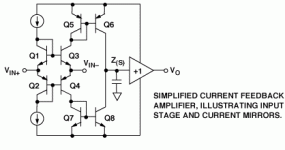
Diamond input buffer or not --- if any circuit does not fundamentally look like this --- it is not a CFA. Strictly speaking. Everything seems to get simplified or dumbed down.... so now we have anything with feedback of any kind to an emitter/source as a CFA.
Just to stay clear. There is a difference. When we go to simplify this further..... down to a minimalist circuit, we could end up with something else. But that can also be pretty good with care.
Thx-RNMarsh

Last edited:
Oh, yes, please, some more distortion numbers, i love to read them on papers.Do you have the foggiest idea what a "diamond buffer" brings to the table?
Do -you have the foggiest idea about the 'musicality' of an amplifier, using your ears ? And the way to be friendly in forums ?
Last edited:
The author of the base design ...
A Paul Kemble web page - T Giesberts; HEXFET and IGBT amplifiers.
..descibes my amp as a CFA.
He also says ... "The term 'current feedback' became applied to low impedance feedback networks which continued to function in a voltage sense"
Is this incorrect , and is "true" CF topological ?
OS
A Paul Kemble web page - T Giesberts; HEXFET and IGBT amplifiers.
..descibes my amp as a CFA.
He also says ... "The term 'current feedback' became applied to low impedance feedback networks which continued to function in a voltage sense"
Is this incorrect , and is "true" CF topological ?
OS
I don't like too much this perfume of jealousy i can feel in those kind of rude answers. I believe L.C. this kind of designer witch spend a lot of time in careful listenings. We can take his reports with consideration and respect. Just try to understand why, and if the 'signature' he reported several times was not due to a specific implantation effect.
The response is not aimed at being rude but its the kind of response one can expect when one reports unsubstantiated evidence and has nothing to do with jealousy.
Yours and LCs posts implies that LCs ears are the best and the only viable ones one can use to valuate sound. We shouldnt even be evaluating our own amps, we should hire LC to do this for us.
One must take into consideration that every single soul on earth will have their own preferences, what LC might like is not neccessarily liked by others.
Will someone please say which post shows a Diamond buffer. Thanks
Can something be agreed upon to be built and listen to so that those that have never heard one can compare it to other topologies. Again Thanks
Can something be agreed upon to be built and listen to so that those that have never heard one can compare it to other topologies. Again Thanks
Member
Joined 2009
Paid Member
He also says ... "The term 'current feedback' became applied to low impedance feedback networks which continued to function in a voltage sense"
taking a black or white position on things invites disagreement, but I do view this comment as more or less accurate. I view all active devices as voltage controlled. It's a shame that the term CFA was not reserved for a feedback loop that senses output current rather than the situation we have now.
By the way, I believe Hugh has said publicly that he uses a Diamond buffer type topology in the output stage of one of his amplifiers and it sounds just marvelous.
The author of the base design ...
A Paul Kemble web page - T Giesberts; HEXFET and IGBT amplifiers.
..descibes my amp as a CFA.
He also says ... "The term 'current feedback' became applied to low impedance feedback networks which continued to function in a voltage sense"
Is this incorrect , and is "true" CF topological ?
OS
This is correct.
The term current feedback has nothing to do with the characteristics of the feedback, see Walt Jungs and Barry Gilberts definition of when and why a amp is called current feedback.
Ive posted this before long ago but I see the most still like to base the analogy on the feedback characteristic.
The answer can be found in Walt Jungs Opamps applications handbook.
Will someone please say which post shows a Diamond buffer. Thanks
Can something be agreed upon to be built and listen to so that those that have never heard one can compare it to other topologies. Again Thanks
Here it is (below 1)..
Below 2/3/4 are the PSRR plots
2= native amp
3= cap multipliers
4= multipliers + a 8200u-1R-8200u CRC PS
BTW - THD = .007% 20khz FULL power 3R load , not too "shabby"😀 .
OS
Attachments
Diamond input has the same out-of the feedback buffer, that's why I don't like them at all. Its signature is clearly audible, even more than bad input cables.
Do you have a real circuit example of 'bad sounding' diamond buffer + measurements of the circuit?
Do you have a real circuit example of 'bad sounding' diamond buffer + measurements of the circuit?
Of course not. It's not about the diamond buffer "sounding bad", but about the non-diamond buffer VSSA "sounding better".
Ostripper,,
what do the two 10Kohm resistors to GND around the VBE do..?? I would expect them to be a source of distortion.
I see the diamond is just another way to bias the input pair, an advantage here is that you just have one FB network.
IRL the tolerances of the two FB networks for the VSSA may be of greater damage than the input diamond, matter of tradeoff i guess
Also try to add a "cherry" nested FB to your circuit. maY lover your 20KHz distortion 10 times. (have not yet implemented it in real life but s working on something.🙂
(I have not any experience with output trippels so I am not sure if substituting the miller cap with cherry compensation will work without oscillation)
what do the two 10Kohm resistors to GND around the VBE do..?? I would expect them to be a source of distortion.
I see the diamond is just another way to bias the input pair, an advantage here is that you just have one FB network.
IRL the tolerances of the two FB networks for the VSSA may be of greater damage than the input diamond, matter of tradeoff i guess
Also try to add a "cherry" nested FB to your circuit. maY lover your 20KHz distortion 10 times. (have not yet implemented it in real life but s working on something.🙂
(I have not any experience with output trippels so I am not sure if substituting the miller cap with cherry compensation will work without oscillation)
Last edited:
Manso, let me try to explain my position. First 'jealousy' was humor (i don't like to use Smileys).The response is not aimed at being rude but its the kind of response one can expect when one reports unsubstantiated evidence and has nothing to do with jealousy.
Yours and LCs posts implies that LCs ears are the best and the only viable ones one can use to valuate sound. We shouldnt even be evaluating our own amps, we should hire LC to do this for us.
One must take into consideration that every single soul on earth will have their own preferences, what LC might like is not neccessarily liked by others.
Second i have equal respect for all the designers who are kind, accurate and modest, at the level of their tries to reach the best and their intellectual honesty.
Having sympathy for one does not mean to lack of it for others. And does not imply i have a high opinion on myself neither.
Just, when an other designer report a personal experience that i don't had myself, or don't understand, my first reaction is curiosity. Not a negative reaction.
I love the L.C. designs from the first sight at one of his schematics. You know, like you like a painter more than an other... Then, it appeared that we had a lot of preferences in common. That's all.
But i'm often shocked by the lack of kindness between people, over here.
By example, each time L.C. try to report some personal experience, with no reference to his own work, some feel like he is promoting his work. I feel-it unfair, as i feel he just try to share. See what i mean ?
I'm sure of one thing, L.C. is working hard, is *very* generous, and absolutely not infatuated. I never feel he is promoting himself.
We are allowed, when we achieve a good result, to be surprised, and happy of it. It is not arrogance, it is just the contrary. Pride of a result, not self pride.
Now, to get back to this diamond buffer story, L.C. has found some 'signature' during its tries, i'm interested to understand why and how and I believe in what he heard, because he is honest with himself and listen carefully. And i understand it can look surprising, an emitter follower not overloaded is not supposed to add noticeable distortion.
Last edited:
- Home
- Amplifiers
- Solid State
- CFA Topology Audio Amplifiers
